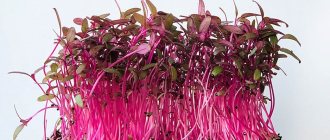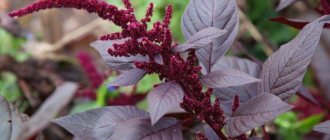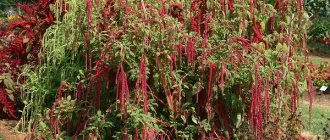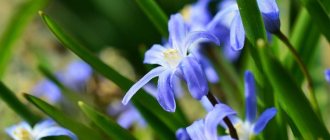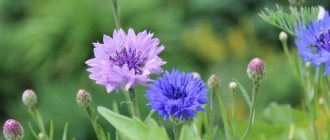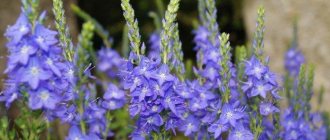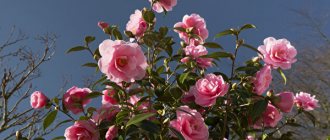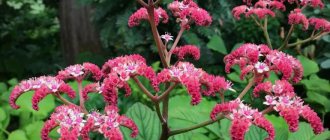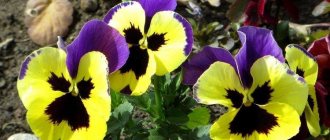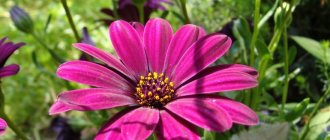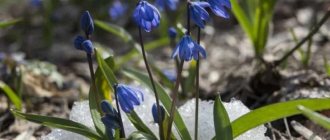Amaranth (from Latin Amaránthus) – this annual perennial is popularly called amaranth. Flowers are often found among gardeners because they have not only smooth outlines and decorative forms, but also useful properties. The flowers have high decorative qualities, and the variety of species allows you to choose not only the one that suits the landscape, but also the most unpretentious variety.
Botanical description
It is an annual, less often perennial, herbaceous plant belonging to the Amaranth family. The decorative effect of the bushes is due to their even shape and size, which is why acorn bushes are also called “soldiers” in the garden. Culture is used not only in decorative, but also in culinary arts.
It is typical for Amaranthaceae to have a thick trunk, elongated leaves and racemose inflorescences formed by many small flowers. The plant blooms for a long time, so it decorates the garden area for several months. This crop reaches a size from 30 cm to 3 meters, therefore, by selecting a variety, you can improve the area in various ways. There are varieties colored purple-red.
The rhizome is thick and strong, goes deep into the soil. Many subsidiary branches extend from the main stem. The root collar is powerful, and a thick and strong stem extends from it. Depending on the variety, the stems may branch or not. Most species are characterized by deepening of the rhizome stem to a depth of more than half a meter.
The entire plant from the base is covered with foliage - elongated, rounded leaf plates with smooth edges, of a bright green hue. They are attached to the plant using a petiole. The surface of the foliage is covered with a network of veins. They are located alternately on the stem. A notch is visible at the top of the leaf plate.
It blooms with axillary inflorescences collected in large drooping racemes. The apical flowers are located at the tips of the shoots. The small flowers that make up the brush can be of different colors - red, purple, white, violet.
In place of the flowers, after the petals fall, a fruit is formed - a box with seeds. More than one and a half million amaranth seeds can form on one bush.
Harvesting
With the onset of September, fruit pods with seeds will begin to form, and the plant itself will gradually lose its decorative appearance. Further actions depend on the purpose for which it was grown.
As livestock feed
In this case, cutting begins even when the bread is actively blooming. This is the time of greatest nutritional value of the feed. If you are late for a couple of weeks, a significant part of the benefit of the forage crop will be lost.
Greens for food
Young greens have a similar taste to spinach. Green leaves measuring no more than 20 cm in length are collected for food consumption. Larger ones will no longer give the desired taste. There is no need to feel sorry for the plant itself; new leaves will grow; however, caution is, of course, necessary.
Stems for food
The stems reach their best taste when they grow 20-25cm. Overripe shoots can be eaten only after heat treatment, because they will become tough.
Grains for food and sowing
The panicles are cut off before they are fully ripe, after which they are laid out to dry in a well-ventilated area. A signal that the crop can be harvested can be yellowing of the lower leaves. The drying process will take about 10 days. After this, the dried boxes need to be rubbed between your palms and the debris removed (it is convenient to use a sieve). After husking, the seeds undergo secondary drying. Their germination lasts 4-5 years. The remaining stems are suitable for livestock feed or for making compost.
It should be remembered that amaranth grown from self-collected seeds can be very different from the plants that produced this seed material. The sooner the panicles are cut off, the less likely this will happen.
Spreading
Amaranth has been cultivated for several centuries. However, wild varieties were mentioned in culture more than 8 thousand years ago. The first mentions of amaranth were noted in the southern regions of America, which is why it is considered the birthplace of this flower. Today culture is found everywhere.
In some countries, Amaranth is grown as a cultivated plant and on an industrial scale. Thus, in India and some regions of China, flour and bread are made from amaranth. The Japanese value ashiritsa, placing it on the same level as squid meat.
In European countries, agaricum is grown as an ornamental annual plant. Many varieties have gone wild here and began to grow like weeds.
Amaranth in landscape design
When designing various compositions with this plant, you need to take into account the size and height of the bush.
Amaranth in the form of a “tree” is well suited for large flower arrangements, as well as for a hedge or tapeworm (single plant). The foliage and inflorescences of various amaranths can harmonize perfectly with ornamental shrubs (barberry, viburnum), perennials and annuals. The combination of reddish-violet and red amaranth with yellowish, white and silvery low-growing crops (rock alyssum, evergreen iberis, jasmine) looks especially original. Amaranth will also look good against the background of lawn grass.
This culture can be used not only for decoration, but also for making salads. Vegetable amaranth grows well in the garden.
There is always a place for amaranth in the garden, as it will decorate flower arrangements throughout the summer and autumn.
Types and varieties
Shchiritsa has more than 60 species in its genus, among which about 30 are popular. Such plants have an unpretentious disposition and are resistant to cold and humidity. Each variety presented has its own characteristics and differences. It is necessary to choose amaranth carefully, since by mistake you can purchase not only decorative, but also fodder varieties of the plant.
Amaranth caudate
It is a tall and durable bush, about 1.5 meters in size. The plant is erect, with a powerful rhizome, dense and thick stem and bright green foliage. The leaves are large, with smooth edges, and hang downwards on the plant. With the help of a strongly recessed rhizome, the bushes do not bend towards the ground even in strong winds.
A special feature of the tailed amaranth is the release of a racemose inflorescence in early June, drooping down in the form of a small tail. The long stalk holds many small flowers in one place, forming a fluffy and decorative inflorescence. In some varieties, the peduncle grows by half a meter.
Rotschwant
Small erect herbaceous shrubs reaching a size of 70 cm. They are distinguished by their spreading nature - the bushes spread a meter or more in width. The foliage of this variety is slightly ribbed and rough to the touch. The racemose inflorescences form several clusters in the form of a panicle. Thus, one panicle can consist of 50 or more flower stalks hanging down from the top of the plant. It is noted that the size of peduncles can reach a size larger than the bush itself. In this case, the flower stalks are located on the ground. The flowers are predominantly red or burgundy.
Grunschfwarz
The appearance of the plant is similar to the previous variety, but the subspecies blooms with rich green racemose inflorescences. Gardeners often grow both varieties locally, since they not only have equal sizes, but also get along well with each other and do not cross. The flowers last for a long time if the brushes are dried and dried.
Raspberry beads
The peculiarity of this flower is the presence of red stems. The bushes themselves are about a meter in size, covered with green foliage with carved edges. The bushes grow strongly on the sides, suppressing the growth of neighboring plants, so they are planted separately.
The inflorescences are bright crimson in color, the racemes hang from the tops for a meter or more, sometimes descending to the ground. Amaranth blooms for a long time, maintaining its decorative effect even after drying.
Amaranth Green Tails
Small plants, reaching a maximum size of 80 cm. The variety is considered one of the rarest, since all the outer parts of the bush are the same green color. This shrub is valued for its bright and long raceme-like inflorescences, hanging down more than half a meter. The bushes themselves are powerful and stand tightly in an upright position. The plants are often planted as hedges because they are so dense that they can protect other crops from the wind.
Avalanche
It is distinguished by decorative inflorescences, the flowers of which look like beads hanging from the top of the bush. The brushes are collected in bunches, forming panicles. Growing this crop will require an abundance of light, so they are planted separately from other plants.
Green torch
Small annual plants, no more than half a meter high, with bright, rich foliage. Leaf plate with smooth edges, rounded shape. Despite its small size, the crop stands on a powerful stem. The variety does not tolerate cold. In favorable conditions it blooms throughout the summer and autumn, until the onset of cold weather. Another feature of the shrub is the vertically upward clusters of inflorescences. Blooms bright green.
Dreadlocks
The most interesting representative of amaranth. It is classified as both caudate and paniculate amaranth, due to the peculiarities of the development of the inflorescence. Together, the brushes gathered into a panicle resemble dreadlocks, which first rise at the top, then hang down. Amaranth blooms with burgundy inflorescences that look like balls. The burgundy color of the panicles and greenery creates a decorative look for the garden.
Amaranth bicolor or tricolor
A peculiarity of representatives of this type of amaranth is the color of the foliage, which combines several different shades. At the same time, different colors are located already at the root.
The foliage of bicolor amaranths is elongated and can have a red=yellow or red-orange color, or a green tint. The height of various bushes ranges from 50 to 80 cm, but some representatives reach one and a half meters.
You may be interested in: Dolichos
Illuminations
It is considered the most decorative representative of amaranth, since it combines several colors at once. The foliage shimmers from red, yellow, to green. Many leaves contain all the colors on one leaf blade. The height of the bushes does not exceed 60 cm, so the plants combine decoratively with other crops in the garden. Young leaves intensify their color as the season progresses, reaching maximum contrast in autumn.
Glamorous glitter
The plant is about half a meter in length. It is a smooth and compact bush, decorated with large leaves. The bottom of the plant is dark green, and towards the top the foliage becomes dark burgundy. The solemn appearance of amaranth does not leave gardeners indifferent.
Molten fire
Tall shrub, reaching 80 cm upward. The foliage below is colored brown, and above it takes on burgundy and scarlet shades. The foliage at the bottom of the shrub is round in shape, while at the top the leaves are elongated, with jagged edges.
Early Splender
An annual representative of bicolor amaranths. It is a tall shrub, about a meter in size, with raspberry-burgundy foliage. The trunks are branched and uneven in shape. Lower foliage with a bronze tint. In the garden, shrubs are often planted next to petunias as a background plant.
Aurora
Bicolor amaranth, the size of which is about 120 cm. The foliage is yellow-green in color, elongated in structure, with jagged edges. The leaves are cream colored on top. It is grown in the garden both with other two-color amaranths and as a separate crop.
Splendence perfecta
Amaranth is a tricolor, cone-shaped, about 1.2 meters in size. The plant prefers single cultivation, because in combination with other varieties it quickly crosses and loses varietal characteristics. The foliage is petiolate, narrow and long. The lower part of the foliage is black, with spots, the upper part is variegated, yellow-red. The decorative effect of the shrub remains throughout the entire season.
Bicolor
The structure of the bush is pyramidal, height is about 90 cm. The lower part of the leaves is dark green, towards the top it takes on a burgundy or bright red outline. The leaves are wavy, elongated in structure. The crop must be grown in sunny areas, as it loses color in the shade.
Amaranth paniculata
A type of amaranth called scarlet. It is an erect fluffy shrub with an abundance of branches. In the garden it grows significantly in different directions, therefore it is cultivated separately from other crops.
The peculiarity of the species is the predominantly vertical arrangement of panicle inflorescences. Only some varieties have drooping panicles due to their heaviness. The size of the main varieties is 35-130 cm. Depending on the size, the crop is divided into low, medium and tall.
Oeschberg
A variety of paniculate amaranth, which is a hybrid of German origin. The size of the crop is approximately a meter. The plant branches heavily, due to which it takes up a lot of space in the garden. Dark green foliage of elongated shape, petiolate. Panicles burgundy color. With high-quality lighting, the color of the panicles changes to brighter and more saturated.
Twins
Shrubs differ in different tones of peduncles. There are green and burgundy color of the panicles. In the middle of the lush bush, a central peduncle is formed - a panicle inflorescence, reaching half a meter in size. The lateral inflorescences do not exceed 10 cm in length. The central peduncle is about 7 cm in diameter and consists of many small flowers. The culture itself is relatively tall and spreading, no more than 80 cm in height. The central trunk is strong and can withstand strong winds without drooping.
Bronze
The tallest representative of amaranth paniculata. It is a two-meter tall plant, with a thick stem that can withstand the weight of many side branches with foliage and inflorescences. The panicles are large, erect, yellow-orange in color. The plant blooms all summer, until frost. Decorative dried flowers are often left over for the winter. The plant lives in sunny areas.
Red Cathedral
A fairly tall representative of amaranth, the size of which is about 1.3 meters. Bright green foliage combined with towering crimson clusters will give the garden an unusual appearance. Blooms for a long period of time. You can grow a crop in the garden only through seedlings.
Bronze Age
The appearance of this variety is similar to the two previous representatives. The variety differs only in its inflorescences - they are bronze. The more light used during cultivation, the brighter the tone of the panicles.
Red torch
A dwarf representative of the paniculate species of amaranths. Despite its small size, it is a shrub with a dense trunk and powerful side shoots. The inflorescence is located mainly in the center of the plant. Blooms with burgundy racemose inflorescences. The disadvantage of this variety is considered to be intolerance to even light frosts. Therefore, the crop is grown mainly in warm, mild climates.
Amaranth fodder
The species category is distinguished by abundant greenery and large flower stalks. The plant is actively used as livestock feed. The plant is unpretentious to any cultivation conditions. It has high productivity.
Giant
A varietal category included in the state register of our country. Shrubs with dark foliage. It blooms with a yellow or red panicle, differing in width and considerable height - the flowers are difficult to grasp with two hands, they hang down 40-50 cm. The plant has abundant foliage and is used as silage. The plants themselves are giants, their size reaches 2 meters. high yield is about 20 tons per hectare.
Lera
The fodder variety, more than 2 meters in size, is characterized by long fruit ripening periods - up to 105 days after planting. The annual has green foliage and stems with red veins. Blooms with red racemose inflorescences. The length of the panicle is just over half a meter. The plant is abundantly covered with foliage and is used as food as the greens of the plant contain essential nutrients.
Aztec
Varietal category with red leaves and inflorescences. Ripens later, preserves flowers until frost. The height of the crop is approximately one and a half meters. The panicles are red, about half a meter in size, hanging down. Flowering and fruiting are abundant.
Kizlyarets
Harvesting of this variety begins 2 months after planting. Used for making silage. The culture consists of extensive shrubs, more than one and a half meters in size. The abundant foliage makes this variety dominant in cultivation. The shrubs are resistant to fungal diseases and pests and are characterized by high productivity.
Cherry jam
A unique representative used for medicinal, food and feed purposes. Quite low-growing shrubs, not exceeding 80 cm in size. The plant is herbaceous and is grown as a perennial in warm climates. It blooms with cherry panicles hanging from the top of the bush. Productivity is high.
Dark amaranth
Compact shrubs, few branches, slightly more than one and a half meters in size. Lanceolate foliage is elongated, purple in color with a hint of green. The bushes grow vertically upward, the inflorescences are erect, dark burgundy or black in color. There is a variety with drooping inflorescences of a bright red hue. the height of common crops is 40-60 cm. The species is used for cutting into bouquets.
White amaranth
Low-growing, few-branched shrubs, about half a meter in size. The foliage of these representatives is light green, almost white. the inflorescences are also snow-white, hanging separately. Some representatives bloom in clusters of heavy inflorescences. drooping flowers.
Red Amaranth
A decorative representative of amaranth, distinguished by bright red leaves and stem. At the same time, the inflorescences differ in shade; they are more saturated and bright. The size of the bush is 2 meters. The stems of the crop are thick, branched, powerful, and can withstand strong winds.
The variety blooms with dark red or burgundy panicles-inflorescences. shrubs are distinguished by their unpretentiousness to cultivation conditions. The peculiarity of the species is its ability to protect the soil from wind erosion.
Amaranth upturned
A weed, popularly called "garden soldier". The size of the crop is one and a half meters. A plant with a red or brown stem, characterized by abundant branching. The roots of this crop are pink. Shrubs grow strongly and, when living in vegetable gardens, interfere with the growth of other crops.
It blooms with a spike-shaped inflorescence of a gray or yellow hue. The flowers are spiny, with an abundance of small black seeds.
Cherry velvet
Decorative representative of amaranth, small in height. The plant is red in color, just over 50 cm tall. It blooms with scattered spikelets, openwork in structure. Individual crops turn purple. The crop can only be grown on loose and fertile soil. The annual plant freezes at the first frost.
You may be interested in: Crocus - delicate primroses in the landscape of the site
Vegetable amaranth
Mainly an ornamental crop used for food. The flowers and foliage of this amaranth are edible and full of useful substances. Different varieties have a height of 30-70 cm and are used for preparing various dishes.
Indoor amaranth
Any variety of amaranth can be grown at home. At the same time, the culture acquires a more compact size. Low-growing varieties such as Rother Dam, Hot Biscuit, and Grunefakel are often used as indoor plants. Caring for these plants is not difficult. The culture is unpretentious and does not differ in care from other indoor crops.
Brief information about amaranth
Amaranth is a prominent representative of the Amaranthaceae family. The main highlight of the annual is its flowering. It is very original and interesting!
Large, velvety and bright inflorescences have an unusual shape and structure and can be colored red, crimson, or burgundy. Amaranth flowering begins in June-July and ends in November. In the lower and upper photographs is Amaranth caudate. By the way, about this!
The most popular decorative types of amaranth:
- Amaranth paniculata;
- Caudate;
- Dark;
- Tricolor.
The average height of the annual plant is 0.7-1.5 meters. Most often, it is tall plants that are found, but there are also medium- and low-growing species. Some species reach gigantic sizes.
Low-height and medium-height varieties are suitable for decorating low borders, flower beds, ridges, and container plantings. Tall amaranths look great as a hedge, in the center of flower beds, mixborders, high borders along garden paths, against the backdrop of lawns; they are ideal for masking unsightly areas and household objects.
The garden crop grows well in sunny, warm areas. Prefers light, fertile soils. It does not tolerate waterlogging, so do not plant it on wet soils.
Planting at home
Despite the fact that most amaranth varieties are large in size, any type can be grown at home. At home, the plant acquires a compact size, grows well and develops on a window or balcony.
At home, purchased amaranth seedlings or seeds are planted. Planting material is placed in a nutritious and loose substrate. The soil used is neutral soil, consisting of peat and a large amount of sand. The health of the bush depends on the quality of the drainage layer and the nutrients in the composition.
Since some varieties grow strongly, a large and wide pot is used for amaranth. A sufficient amount of space will ensure normal development of the root system. Amaranth is not transplanted, since even at home it grows as an annual.
Growing seedlings
Amaranth is sown in April. Seeds are planted in containers with moist soil. Seeds are sown one at a time, in furrows about 1.5 cm deep. After placing the seeds, the furrows are sprinkled with a layer of earth. It is recommended to maintain a distance of about 5 cm between the rows. In this form, the seeds germinate quickly, producing the first shoots within a week. If necessary, seedlings are thinned out, leaving a distance of about 7 cm between individual bushes.
After the crop reaches a size of about 10 cm, it is planted in separate pots. Immediately after this, fertilize with nitrogen fertilizer. Flowers ripen in the 3rd-4th month after cultivation.
Home care
Pots with amaranth are placed in well-lit areas, in direct sunlight. If there is insufficient lighting, it is created artificially.
Amaranth grows in warm climates. The optimal conditions for growing crops are 18-20 degrees. The plant cannot tolerate low temperatures and dies at 6 degrees above zero.
There is no need to spray amaranth regularly. The plant does not require constant moisture and grows well in dry conditions. However, for normal development, the bush is regularly washed in the shower.
Watering indoor amaranth is carried out as the top layer of soil dries. The plant has good hardiness and drought resistance.
During the active growing season, 3 fertilizers are applied to indoor amaranth:
- The first fertilizing is carried out before planting the seeds. Superphosphate is added to the soil;
- After the appearance of 3 permanent leaves, a complex of minerals is added;
- Before flowering, a mineral complex is also added.
An important condition for growing amaranth is its instability to inorganic fertilizers, which cannot be applied to the soil.
For food or for beauty?
In the wild, shiva is widespread in America and East Asia. In ancient times, it was cultivated along with legumes and corn and was considered one of the main grain crops. Not all of its varieties are edible, nor are all of them decorative. But there are varieties that combine both beauty and benefit. For example, amaranth is tricolor and paniculate. And the tailed and sad amaranths are grown for their decorative properties, although they are also the most valuable animal feed in agriculture. Therefore, when planning to grow amaranth from seeds as an agricultural or ornamental crop, it is necessary to understand the varietal variety and purpose.
You can determine the edibility of already ripened grains by their color. In purely decorative varieties, they have a dark color; such seeds are unsuitable for food. Vegetable and grain velvet produces light-colored seeds.
To grow amaranth at home, buy seeds only from official manufacturers! The tendency to cross-pollinate often leads to the fact that from seeds collected independently or purchased from an unscrupulous seller, something unsuitable for either food or beauty grows.
Planting in open ground
Growing amaranth in the garden is not difficult. The main difficulty arises only at the beginning of cultivation, when the bushes are just beginning to actively grow. You can get ready-made plants from seeds or seedlings purchased in a store. In the first case, the seedlings slowly gain growth, which is why gardeners often worry. With sufficient light, humidity and watering, amaranths develop quickly, beginning to bloom within a few months after planting.
Amaranths grown in the garden are unpretentious to cultivation conditions. The plants grow actively among weeds, do not require regular watering, and are drought and wind resistant.
How to plant amaranth
You can grow an annual from seeds or seedlings. In the second case, the crop is pre-grown in containers, then transplanted into the soil when the soil warms up to the optimal temperature.
Planting amaranth using seeds is also not difficult, but requires careful attention to detail. Sowing is carried out at the end of April, when the soil warms up to a thickness of about 5 cm. Planting material is sown 1 at a time, in pre-prepared holes 1.5-2 cm deep. It is recommended to maintain a distance of at least half a meter between rows, and 7-10 cm between seeds. Despite the fact that the seed is small, gardeners prefer to immediately divide the seeds among themselves.
When planted in open ground, the seeds germinate quickly. When their size reaches 15-20 cm, and permanent leaves appear on the crop, the seedlings are pruned or thinned out. At the same time, the soil is fertilized with nitrogenous fertilizer. With optimal care, the seeds sprout within the 3rd month after sowing.
Growing through seedlings
Amaranth is planted through seedlings at the end of March. Nutritious and loose soil is poured into the container, which is slightly compacted and moistened. The seeds are distributed over the surface of the soil, then lightly sprinkled with soil. For quick germination, create greenhouse conditions by covering the planting with film. The crops are ventilated regularly.
After the first shoots appear, the seedlings are opened and placed in a bright, warm place for further growth. After permanent leaves appear, the seedlings are planted in different pots. With regular watering, already on the 20th day the bushes are ready to be transplanted to a permanent place, but the procedure is carried out at the end of May, when the soil has warmed up sufficiently.
Before transplanting into open ground, seedlings are fed with nitroammophos.
Preparing for sowing
Preparatory work allows you to obtain uniform seedlings and grow strong seedlings.
Seed selection
You need to buy amaranth seeds in specialized stores. Otherwise, you may encounter a fake and purchase wild species that have low decorative qualities or are not used for food.
When choosing seeds, consider the following features:
- Amaranth seeds with green leaves have a beige or cinnamon hue. The surface of the seeds is smooth and shiny;
- amaranth with red leaves has small black seeds.
Seeds collected from the site should not show signs of damage or mold.
Preparing seeds for sowing
Amaranth seeds are very small and have a good germination rate of about 90%, so no preparation is carried out before sowing.
Soil selection and preparation
The plant prefers loose soil. To grow seedlings, you can purchase a commercial substrate intended for violets.
If desired, you can prepare the soil mixture yourself. To do this, mix:
- 1 part turf;
- 2 parts peat;
- 1 part humus;
- 1 part coarse river sand.
The resulting composition is thoroughly mixed and fried in an oven to eliminate fungus and pest larvae. The duration of heat treatment is 20 minutes at a temperature of 70-90°C.
Choosing a container for seedlings
To plant seeds, use a container 10 cm high. The bottom of the container should have drainage holes to remove excess water. You can use plastic cups, pots, boxes, or food packaging as containers.
Before use, the container is treated with a solution of potassium permanganate. Mix 2 grams of substance in 1 liter of water. This treatment is necessary to disinfect containers.
Care
Caring for amaranth is easy. During the first months, care is taken to ensure that the seedlings do not come into contact with weeds. This is due to the slow growth of a young crop, which may stop developing due to weeds. Young crops also need regular loosening to ensure the supply of oxygen to the roots. Adult plants are resistant to temperature changes, prolonged drought and other living conditions, and therefore do not require regular inspection.
The soil
Garden amaranths grow actively in a neutral environment. It is optimal to plant the plant in soil with equal parts of peat, sand and garden soil. After planting, the soil layer is mulched to prevent the development of weeds and drying out of the soil.
Watering
Garden amaranths are watered several times a week. As they grow, watering is reduced and done once a week, or 2 times in dry climates.
Trimming
When the crop grows 25-30 cm upward, the stems are cut. After pruning, only a few buds should remain on the stems for development. Side branches are also pinched to fluff up the crop.
Top dressing
After planting in open ground, garden crops are recommended to be fed with mullein or green manure. Fertilizers are applied in the morning to moist soil.
Weeding and loosening
Weeding and loosening of amaranth is carried out only in the first 2 months after planting. When the plant begins active growth, weeding and loosening are reduced. The soil in the area where amaranth grows is mulched to maintain the required level of moisture.
Air humidity
For garden amaranth, air humidity is important only in the first months after planting. It is maintained by spraying the crop. The procedure is carried out in the morning or evening hours.
Location
Amaranth is a light-loving plant, so it is planted in sunny areas, away from drafts. The plant is not afraid of direct sunlight, and prolonged shading leads to inhibition of flowering.
Temperature
The flowers are thermophilic. The annual grows actively at temperatures of 18-25 degrees. The plant does not tolerate frost and dies at temperatures of 6 degrees and below.
Transfer
Since amaranth is primarily grown as an annual, it does not require replanting.
Pest control measures
Any type of amaranth is quite resistant to various kinds of parasites. Complete destruction of the crop is considered unlikely, but the lack of timely treatment is fraught with the loss of up to 40% of the crop:
- The meadow moth is a butterfly of the moth family - light brown in color with dark spots on the wings. The cover may have a tint of yellow. Greater damage is caused by its pale green caterpillars. Spraying amaranth with a solution of sodium silicofluoride, systematic cleaning of crops manually and with store-bought biological products are effective.
- The beet flea beetle is a small bug with an elongated body about 2 mm of bronze color with tiny antennae. Damaged amaranth leaves become covered with small holes. Successful means of struggle are:
- timely compliance with crop rotation;
- compliance with planting deadlines;
- weeding.
Chemical control agents are used in more severe cases. The seeds are treated in advance and the plants are treated with insecticides.
To combat agricultural pests, we recommend karbofos (malathion), a broad-spectrum insecticide.
- Aphids are a common pest of almost any crop. It has a rounded green abdomen measuring 1-2 mm. Timely control - namely treating young shoots with a solution of laundry soap (200 grams per bucket of water), spraying with garlic water (2-3 heads and half a bucket of water) - will help protect the stems, leaves, seeds and flowers of amaranth. In advanced cases, you should purchase special products based on fatty acids or pyrethrins, as well as essential oils.
- Cruciferous flea beetle is characterized by the presence of long antennae, but depending on the species it has a different color (from dark to very light), no more than 2 mm in length. The insect attacks young leaves. Compliance with timely agrotechnical measures and spraying with organic products will help get rid of flea beetles. It is recommended to sprinkle the plants with tobacco dust, first combining them in equal proportions with phosphate rock or lime.
Share
Amaranth after flowering
After flowering, achenes are formed - amaranth fruits. If you want to grow a crop for the next year, harvest it. Seeds are collected from the healthiest plants when the lower foliage and stem have dried out. The inflorescences are cut from the plant and placed until completely dry in a well-ventilated area.
You may be interested in: Hawthorn is a magnificent and medicinal plant in every area
When the panicles are completely dry, by rubbing with your hands, the dry seeds easily fall out of the box. The seed material is sifted through a sieve and placed in paper bags for storage. Seed germination is maintained for 5 years.
Collecting seeds from the site
Amaranth seeds are collected only after the inflorescences have fully ripened. The most optimal period is considered to be from late August to mid-September. The collection process is carried out as follows:
- after the panicles have finished flowering, they are carefully cut off and placed on the windowsill for 2 months until fully ripened;
- The ears are kneaded so that the seeds fall out.
- then the grains are sifted through a fine sieve and placed in a dark, dry place.
Reproduction
Amaranth can be propagated in several ways. Each reproduction method has its own characteristics. Most often, the plant is produced by seed, since annuals are not able to share cuttings or roots.
The seeds are collected in the fall, when the plant dries out. It is important to collect the seeds in time before they fall to the ground. In the spring, collected and dried seeds are planted in open ground or in containers to obtain a new crop.
General information about arrowroot tricolor
Arrowroot tricolor (Maranta trikolor) is a perennial evergreen plant of the arrowroot family, native to the humid South American tropical forests. It grows up to 40 cm in height and slightly less in width.
Particularly interesting are its small oval velvety leaves growing on short petioles. They are dark green in the center and lighter at the edges. They are characterized by clearly visible red-crimson veins.
For this plant received another name - arrowroot fascinator or red-veined.
Along the central vein there is a pattern characteristic of this plant, consisting of a jagged, light stripe framed by dark streaks.
On the reverse side the leaves are monochromatic - lilac-violet.
Another name for arrowroot tricolor is associated with the special mobility of its leaves. In comfortable conditions, they are located horizontally, almost spreading above the ground.
With a lack or (under natural conditions) excess of light, they become vertical, resembling palms during prayer. For this reason, Tropicana is often called a prayer plant.
In summer, arrowroot is mature and blooms with small white or purple flowers. Their spike-shaped inflorescences are lost against the background of the luxurious, picturesque, colorful beauty of the rosettes of its velvet leaves.
Diseases and pests
Shchiritsa is considered a plant that is used as fertilizer after drying. The culture has a positive effect on other plants and improves the composition of the soil. However, the plant itself is vulnerable; if not properly cared for, it can be damaged by pests and become sick.
Diseases
The main disease of acorn grass is considered to be a fungus that attacks the rhizome and the outer part of the crop when the soil moisture is high. Fungicidal solutions are used as treatment methods, which are sprayed onto the crop several times.
Pests
Among the pests that settle on amaranth are aphids and weevils. In the first case, the insect spreads throughout the crop. Weevils settle on stems. Pests can be eliminated by treating the bushes with insecticides.
Story
There are a lot of legends about it and its history stretches back to ancient times. The native side of this plant is America. Ancient Indian tribes called the amaranth flower “the golden grain of God,” “the wheat of the Aztecs,” “the bread of the Incas,” and it served them as a symbol of immortality. After corn, it was the second food plant among the Indians, but its beneficial properties were great.
But, ultimately, the cultivation of amaranth was prohibited, due to some Indian traditions, the essence of which was to make human figurines from amaranth flour, honey and human sacrificial blood. The source of the ban was the Catholic Church, which considered it “the plant of the devil.” The penalty for cultivation was death, and only tribes living in the inaccessible mountainous regions of Central America could cultivate this crop without hindrance.
We also recommend reading
- Landscape design of a small summer cottage
- Design on 6 acres
Only several centuries later there was a revival of this product, thanks to the study of its most valuable properties. Today, the cultivation of amaranth has reached a global scale, if we talk about its cultural representatives. Shchiritsa, or wild species, is even more widespread.
Chemical composition
Amaranth has a unique chemical composition. All parts of the plant are used, including the seeds, roots, leaves and stem. The chemical composition of the plant is unique, containing elements such as:
- protein;
- polyunsaturated acids – linoleic, linolenic, oleic;
- flavonoids and vitamins;
- pectin and carotene;
- iron;
- copper, sulfur, phosphorus;
- sodium, magnesium, potassium, calcium.
In terms of protein content, amaranth is not inferior to meat or soy. However, amaranth protein is absorbed much better than in these products. The seeds are of the greatest value because they are considered dietary products due to the absence of gluten.
Possible problems
This plant belongs to the unpretentious category. But ignoring the rules of care can cause various problems.
The most common of them:
- Amaranth does not bloom . This mainly occurs due to excessive application of nitrogen fertilizers to the soil. In this case, the plant increases its green mass, to the detriment of flowering. To correct the situation, you need to fertilize with a high content of phosphorus and potassium.
- Sharp wilting of amaranth . This plant reacts poorly to stagnant moisture in the soil. In this case, its root system rots, which leads to loss of turgor in the leaves and shoots. In this case, it will not be possible to save amaranth.
- Slow growth rate . Most often, the problem occurs when planting amaranth in acidic, heavy soil. Therefore, it is recommended to transplant it to a more suitable place.
Application
Amaranth is used not only as an ornamental crop. Some types are used in the agricultural industry, cooking and medicine. In some countries the plant is used as a vegetable.
At home
The main household purpose of amaranth is food. Various varieties of the crop are used for livestock feed in fresh form and in the form of silage. The vegetable species is used as a delicacy. Many countries grow amaranth plantations, thanks to which the plant is considered one of the most popular grains in many countries.
In cooking, grains are used that taste and smell similar to nuts. Drinks, sauces and confectionery products are made from them. The stems and leaves are suitable for fresh consumption, in salads, in a cooked state - side dishes, for fish and meat dishes.
In cosmetology, amaranth is used as an oil and extract. Such products are enriched with vitamins and minerals that saturate the skin with essential elements. Under the influence of the substances, the skin is restored and becomes more elastic. The development of cancer cells is prevented. The preparations moisturize and nourish the skin. Under the influence of oil, cell aging slows down.
In medicine
Amaranth grains are used in traditional medicine. The plant has a general strengthening effect on the heart and blood vessels, stimulates the development of immunity, and helps fight flu and colds. Based on the culture, drugs with a calming and strengthening effect on the central nervous system are prepared.
Preparations with amaranth are used to treat diseases such as hemorrhoids, inflammatory diseases of the genitourinary system, and diabetes. Amaranth improves metabolism, which is why it is used in anti-obesity medications. The healing properties of amaranth have led to the use of the plant for burns, periodontitis, and stomach ulcers.
The following properties of amaranth are also known:
- improvement of hormonal levels;
- analgesic effect;
- facilitates the course of the disease;
- restores skin.
The plant is used not only as part of medicines. In some countries, amaranth teas and infusions and tonic decoctions can be purchased in pharmacies.
In folk medicine
For traditional medicine, amaranth is a storehouse of useful substances that is used to treat many diseases. The plant nourishes the body and has a strengthening and healing effect. Based on it, various decoctions and infusions are prepared that can not only cure, but also lift your spirits.
Recipes
- If wounds appear on the skin, lubricate the damaged surface with amaranth oil 3-4 times a day
- Tonic infusion - 2 tbsp of dry amaranth powder is poured with 2 cups of boiling water, covered with a lid and placed in a dark, warm place to infuse for half an hour. Take the infusion 2 times a day, half a glass before meals.
- To strengthen the immune system, pour 10 grams of fresh crushed amaranth leaves into a glass of boiling water and cook in a water bath for 20 minutes. The broth is filtered and taken half a glass twice a day.
- Bath with amaranth - 0.5 kg of fresh greenery is poured into 2 liters of boiling water and boiled for a quarter of an hour, then infused for another half hour. The finished broth is filtered and poured into the finished bath. Take this bath for at least half an hour.
- For inflammation of the throat and oral cavity, the juice of fresh amaranth leaves is mixed with boiled water in a ratio of 1:5. Gargle with the resulting solution every 2 hours.
- For enuresis, the inflorescences are crushed to form a porridge. A tablespoon of the mixture is poured into a glass of boiling water and cooked in a water bath for a third of an hour. The mixture is cooled and filtered. Fill with boiled water to the previous volume and take half an hour before meals for 2 weeks.
Contraindications
Medicines containing amaranth have a potent effect and are therefore not recommended for many diseases:
- Acute cholecystitis;
- Urolithiasis disease;
- Gallstone disease (drugs can cause stones to move);
- Acute pancreatitis and gastric ulcers.
Also, the plant cannot be used if you are allergic to drugs.
In landscape design
The plant is actively used to decorate the landscape. Shrubs, depending on their size, are used as single crops or together with other species. When planting a flower, take into account the size of the crop, its degree of growth and the possibility of proximity to other flowers.
Amaranth is suitable as a crop for creating a hedge. Amaranth flowers go well with bushes such as barberry, bladderwort and other perennials and annuals. Tall varieties are planted as a background for shorter, shade-loving crops. The plant looks decorative against the background of the lawn.
Interesting Facts
- Amaranth was considered a sacred plant by the Aztecs and Incas.
- In Spain, the cultivation of amaranth was prohibited, so it is difficult to obtain there.
- In Japan, the plant is comparable to squid meat.
- Daily use of amaranth helps compensate for protein and vitamin deficiencies.
- The price of amaranth oil is much higher than other medicinal oils.
- In terms of usefulness, sprouted grains of the crop are comparable to mother's milk.
Amaranth is an unusual and useful plant that can not only decorate an area, but also cure various diseases. The plant is actively used in traditional and folk medicine because it contains a unique chemical composition. The article allows you to identify popular types of plants, ways to grow amaranth at home and in the garden.
Useful properties and contraindications
For medicinal purposes, caudate amaranth is mainly used. To obtain raw materials, leaves are collected before flowering, and during flowering the panicles are cut off. Then comes the turn of collecting seeds and digging up roots.
Amaranth seeds are rich in protein. It is similar in composition to cow's milk.
Amaranth seeds can be consumed daily as a dietary supplement
Healing oil is made from the seeds and is used for the following problems:
- atherosclerosis;
- heart pathologies;
- high blood pressure;
- female gynecological diseases (cervical erosion, ovarian inflammation, fibroids);
- cataracts;
- dysfunction of the gastrointestinal tract;
- periodontitis.
Thanks to its immunostimulating and regenerating properties, amaranth promotes faster treatment of burns, cuts, suppuration and tumors. It has a beneficial effect on the skin, preventing premature aging.
Fresh salads are prepared from amaranth leaves, which benefit people with diabetes, excess body weight and those suffering from chronic constipation. For the winter, you can dry the grass and use it as a seasoning.
One of our readers spoke in more detail about the anti-cancer properties of amaranth in the article.
Contraindications
Despite many beneficial properties, amaranth has a number of contraindications. These include:
- individual intolerance to individual components in the composition;
- urolithiasis or cholelithiasis;
- acute pancreatitis and cholecystitis.
Side effects include nausea and slight dizziness.
Popular varieties of amaranth
The most common amaranth varieties for our climate:
- amaranth paniculata. Plant height is from 80 to 150 cm. It is used as animal feed, for decorating garden flower beds, and also for making winter bouquets. Amaranth flowers have a rich red hue; the plant blooms from the beginning of summer almost until the cold weather;
- dark (sad). Height about 150 cm, low-branched appearance with burgundy inflorescences;
- tricolor. It looks like a pyramidal bush with straight stems. The leaves are painted in a palette of red, yellowish and green colors. Used for decorative purposes only. Young leaves are especially beautiful;
- caudate. Description of this amaranth - an excellent dried flower, suitable for cutting and live. Used for decorative purposes.
Any of the varieties of amaranth will become a real decoration of the garden plot.
Selection of planting material
When choosing seeds, first of all pay attention to the characteristics of the variety you like. The plant must be suitable in size, flowering time and other characteristics. Be sure to check the expiration date indicated on the packaging.
The fresher the planting material, the better. It is advisable to choose seeds from a reliable manufacturer, whose products have already been tested and are trustworthy.
By the way, not all varieties of amaranth are decorative.
The crop includes grain, vegetable and fodder varieties. The most common decorative species is scarlet amaranth. By the way, in the future the plant easily reproduces by self-sowing. The seeds do not require any preliminary preparation for sowing; they germinate easily without it.
